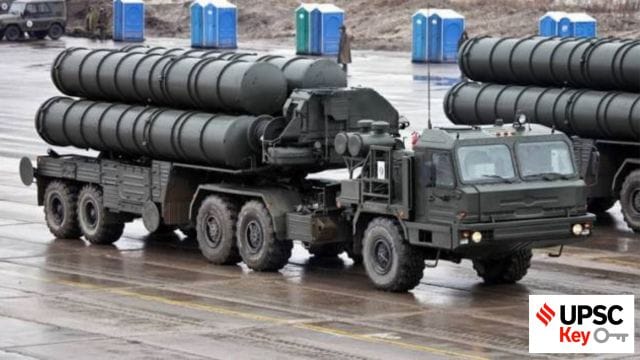UPSC Key: Air Defence system, IMF Bailout and Pope Leo XIV
Why US-UK trade deal is relevant to the UPSC exam? What is the significance of topics such as UK’s carbon tax, the BrahMos missile and IAF’s Pechora Missile on both the preliminary and main exams? You can learn more by reading the Indian Express UPSC Key for May 9, 2025.
 UPSC Key May 2025: Here's what you should be reading from the May 9, 2025 edition of The Indian Express
UPSC Key May 2025: Here's what you should be reading from the May 9, 2025 edition of The Indian Express Important topics and their relevance in UPSC CSE exam for May 9, 2025. If you missed the May 8, 2025 UPSC CSE exam key from the Indian Express, read it here
FRONT PAGE
Lahore air defence neutralised after Pak targets Indian military sites: Govt
Syllabus:
Preliminary Examination: Current events of national and international importance.
Mains Examination:
• General Studies III: Achievements of Indians in science & technology; indigenization of technology and developing new technology.
• General Studies III: Role of external state and non-state actors in creating challenges to internal security
What’s the ongoing story: A day after Operation Sindoor which targeted and destroyed nine terror sites in Pakistan and Pakistan-occupied Kashmir, the Indian Armed Forces Thursday neutralised an air defence system in Lahore after several sites along the Line of Control were targeted in retaliation.
Key Points to Ponder:
• What do you understand by ‘Air Defence system’?
• How Air Defence system work?
• The Indian Armed Forces neutralised an air defence system in Lahore—How does this reflect on India’s military capabilities and doctrine?
• What is ‘Suppression of Enemy Air Defences’ or SEAD?
• How effective are India’s Integrated Counter-UAS Grid in countering unmanned aerial threats?
• ‘India had called its response as focused, measured and non-escalatory’—what does “focused, measured and non-escalatory” mean?
Key Takeaways:
• Reiterating that any attack on military targets in India will invite a suitable response, India said Pakistan attempted to engage a number of military targets in Northern and Western India including Awantipura, Srinagar, Jammu, Pathankot, Amritsar, Kapurthala, Jalandhar, Ludhiana, Adampur, Bhatinda, Chandigarh, Nal, Phalodi, Uttarlai, and Bhuj, using drones and missiles.
• The Armed forces emphasised its commitment to non-escalation, warning that it should be respected by the Pakistani military.
• “During the Press Briefing on Operation SINDOOR on 07 May 2025, India had called its response as focused, measured and non-escalatory. It was specifically mentioned that Pakistani military establishments had not been targeted. It was also reiterated that any attack on military targets in India will invite a suitable response.
• On the night of 07-08 May 2025, Pakistan attempted to engage a number of military targets in Northern and Western India including Awantipura, Srinagar, Jammu, Pathankot, Amritsar, Kapurthala, Jalandhar, Ludhiana, Adampur, Bhatinda, Chandigarh, Nal, Phalodi, Uttarlai, and Bhuj, using drones and missiles. These were neutralised by the Integrated Counter UAS Grid and Air Defence systems. The debris of these attacks is now being recovered from a number of locations that prove the Pakistani attacks.
• Today morning Indian Armed Forces targeted Air Defence Radars and systems at a number of locations in Pakistan. Indian response has been in the same domain with same intensity as Pakistan. It has been reliably learnt that an Air Defence system at Lahore has been neutralised.
• Pakistan has increased the intensity of its unprovoked firing across the Line of Control using Mortars and heavy calibre Artillery in areas in Kupwara, Baramulla, Uri, Poonch, Mendhar and Rajouri sectors in Jammu and Kashmir.
• Sixteen innocent lives have been lost, including three women and five children, due to Pakistani firing. Here too, India was compelled to respond to bring Mortar and Artillery fire from Pakistan to a halt.
• Indian Armed Forces reiterate their commitment to non-escalation, provided it is respected by the Pakistani military.”
Do You Know:
• The primary objective of an air defence system is to take out threats from the skies — be it enemy fighter aircraft, unmanned drones, or missiles.
This is done with the help of a complex system of radar, control centres, defensive fighter aircraft, and ground-based air defence missile, artillery, and electronic warfare systems.
An air defence system can be sub-categorised into three interlinked operations.
—DETECTION: Key to the success of any air defence system is its ability to detect threats in the first place. This is typically done by radar, although satellites may be used in certain circumstances — such as an enemy launching an Intercontinental Ballistic Missile (ICBM).
—TRACKING: The efficiency of an air defence system is also determined by its ability to constantly and accurately track — and not merely detect — an aerial threat. This is typically done using a combination of radar and other sensors such as infrared cameras or laser rangefinders.
—INTERCEPTION: Once the threat has been detected and tracked, it must be neutralised. Here, the specifics of the threat — its range, type (what kind of missile/ aircraft), speed, etc. — determine the ways in which air defences work.
Other Important Articles Covering the same topic:
S-400, Akash missiles key to IAF shield against Pak missiles and drones
Syllabus:
Preliminary Examination: Current events of national and international importance.
Mains Examination:
• General Studies III: Achievements of Indians in science & technology; indigenization of technology and developing new technology.
• General Studies III: Role of external state and non-state actors in creating challenges to internal security
What’s the ongoing story: India’s flagship surface-to-air missile systems — S400 Triumf, Barak 8 MRSAM (Medium Range Surface to Air Missile) and the indigenous Akash — played a key role as the IAF activated its Integrated Counter UAS (Unmanned Aerial Systems) Grid and other air defence systems to thwart the attacks by Pakistan on 15 military bases and several cities Thursday (May 8).
Key Points to Ponder:
• The S-400 Triumf air defense system—know its key highlights
• Why Akash missile system is unique?
• Know the strategic significance of the S-400 and Akash missile systems in strengthening India’s air defense capabilities.
• Compare and contrast the S-400 and Akash missile systems in terms of range, guidance mechanisms, and deployment platforms.
• What do understand by ‘Long-range Surface-to-Air’ and ‘Medium-range SAM’?
• What is the Pechora missile system in India?
• Why is the IAF’s Pechora Missile called a “Stealth Killer”?
Key Takeaways:
• Sources told The Indian Express that the air defence shield set up by the IAF, using guns, radars, missiles and the counter-UAS grid to jam and spoof UAVs (Unmanned Aerial Vehicles), prevented the Pakistani drones and missiles from reaching Indian military installations.
• The sources said Pakistan launched a swarm of drones and missiles between 1 am and 1.30 am Thursday morning, with India’s air defence systems immediately tracking the threats and destroying them. The debris is now being recovered from several locations.
• Responding to the Pakistani attack on Indian military installations, India also attacked their military targets, even taking out an air defence system in Lahore, using its latest loitering munitions such as the Israeli HAROPs and the HARPYs. These can “loiter” or hover in the air close to the designated target before self-destructing on impact.
• According to sources, India deployed the lethal S-400 in the northern borders facing Pakistan after receiving three squadrons of the missile system from Russia with more to be delivered by this year-end.
• Sources said most of the military installations targeted by Pakistan were of the IAF in locations such as Ludhiana and Awantipora — the Army’s bases are co-located with these IAF bases.
Aside from the S-400, sources said, India deployed a range of other surface-to-air missile systems across its northern and western borders as part of its air defence, including the S-125 Pechora and the indigenous Akash.
• Over the past few years, India has built up its arsenal with a range of drones, including a range of loiter munitions, with the IAF and the Army’s artillery regiment.
Do You Know:
• Considered one of the most advanced and potent air defence systems in the world, S-400 Triumf has the capability to protect against almost all sorts of aerial attacks, including drones, missiles, rockets and even fighter jets. The system, intended to act as a shield over a particular area, is a long-range surface-to-air missile system.
—Named SA-21 Growler by NATO, and developed by Russia’s Almaz Central Design Bureau, S-400 can engage intruding aircraft, unmanned aerial vehicles, cruise missiles, and ballistic missiles, a recent article in US Air Force’s Journal for Indo-Pacific Command stated. It has “surfaced as an anti-access/area denial (A2/AD) asset designed to protect military, political, and economic assets from aerial attacks”.
—S-400 detects an aerial threat approaching the air defence bubble (the area it has to protect), calculates the trajectory of the threat, and fires missiles to counter it.
It has long-range surveillance radars that sends information to the command vehicle. On identifying the target, the command vehicle orders a missile launch.
• The development of the Akash SAM was started by the DRDO in the late 1980s as part of the Integrated Guided Missile Development Programme. The initial systems trials and field trials along with the target neutralisation trials were conducted in the late 1990s and 2000s. These were followed by extensive user trials by the Indian Air Force and Indian Army.
—Named after the original Sanskrit term for sky or space, Akash is primarily a Short Range Surface to Air Missile built to provide air defence cover to the vulnerable areas. The Akash weapon system can simultaneously engage multiple targets in group mode or autonomous mode. It has built-in Electronic Counter-Counter Measures (ECCM) features, which means that it has mechanisms on-board that can counter the electronic systems that deceive the detection systems.
—The entire weapon system has been configured on a mobile platform. A full Akash missile system comprises a launcher, set of missiles, a control centre, an built-in mission guidance system and a C4I (command, control communication and intelligence) centres and supporting ground equipment along with a radar named Rajendra which accompanies each of the missile batteries.
• The MRSAM is a surface-to-air missile jointly developed by DRDO and Israel Aerospace Industries (IAI) for use by the Indian Army. The missile will replace the ageing Air Defence systems of the Army. The MRSAM weapon system comprises multi-function radar, mobile launcher system and other vehicles. It has Army, Navy and Air Force variants.
Other Important Articles Covering the same topic:
📍Explained: S-400 purchase & implications
📍Explained: What are the two advanced versions of Akash missile?
IMF board should look deep within before bailing out Pak: Misri
Syllabus:
Preliminary Examination: Current events of national and international importance.
Mains Examination: General Studies II: Important International institutions, agencies and fora- their structure, mandate.
What’s the ongoing story: A day before the International Monetary Fund (IMF) is set to review the financing facilities extended to Pakistan, India’s Foreign Secretary Vikram Misri on Thursday said the Fund’s Board should look “deep within” and take into account the facts before generously bailing out the country. He questioned the efficacy of several bailout packages extended to Pakistan over the last three decades and raised questions on its utilisation by the country.
Key Points to Ponder:
• What is IMF bailout?
• Has India been bailed out by the IMF?
• What is the IMF bailout deal with Pakistan?
• What is the name of the IMF program under which Pakistan is currently receiving financial assistance?
• What is the primary concern India has regarding IMF funds being provided to Pakistan?
• Know the implications of repeated IMF bailouts to Pakistan on regional security.
• Analyse the role of international financial aid in perpetuating or mitigating state-sponsored terrorism, using Pakistan as a case study.
• What is the International Monetary Fund (IMF)?
• What does the IMF do?
• How does the IMF give policy advice?
• What kind of financial assistance does the IMF offer?
Key Takeaways:
• Misri said India’s Executive Director will put forward its position at the IMF Board meeting on May 9. “We have an executive director at the IMF. Tomorrow there is a meeting of the board of the IMF, and I am sure that our Executive Director will put forward India’s position.
• The decisions of the Board are a different matter, you know, the process through which they are made. But, I think the case with regard to Pakistan should be self-evident to those people who generously open their pockets to bail out this country…,” he said.
• Misri pointed out that there have been several IMF bailout programmes sanctioned in the space of the last three decades. “…I think you would also have an idea on how many of those programmes have reached successful conclusions. Probably, not many. So, I think this is a decision that (IMF) Board members have to take by looking deep within themselves and looking at the facts,” he said.
• As per the IMF website, there have been 25 arrangements for Pakistan since it became a member of the IMF in 1950. As of March 31, 2025, the outstanding purchases and loans to Pakistan from the IMF stood at 6.23 billion Special Drawing Rights.
• The IMF is financing a $7-billion aid package to Islamabad that was approved in September 2024. The ongoing 37-month long Extended Fund Facility programme of the IMF consists of six reviews over the span of the bailout, and the release of the next tranche of approximately $1 billion will be contingent upon the success of the performance review.
• Parameswaran Iyer, Executive Director at the World Bank, who has been temporarily entrusted with the responsibility of being India’s nominee director on the IMF Board will be part of the crucial May 9 Board meeting. Iyer’s nomination was made after the termination of services of Krishnamurthy V Subramanian as the Executive Director at the IMF, six months before the end of his three-year tenure.
• India intends to speak with all multilateral development banks (MDBs) to push back against providing funds and loans to Pakistan amid rising tensions between the two countries, a senior government official had said last week.
Do You Know:
• The IMF assists countries hit by crises by providing them financial support to create breathing room as they implement adjustment policies to restore economic stability and growth. It also provides precautionary financing to help prevent and insure against crises. The IMF’s lending toolkit is continuously refined to meet countries’ changing needs.
• Unlike development banks, the IMF does not lend for specific projects. Instead, the IMF provides financial support to countries hit by crises to create breathing room as they implement policies that restore economic stability and growth. It also provides precautionary financing to help prevent crises. IMF lending is continuously refined to meet countries’ changing needs.
• The causes of crises are varied and complex. They can be domestic, external, or both.
Domestic factors include inappropriate fiscal and monetary policies, which can lead to large current account and fiscal deficits and high public debt levels; an exchange rate fixed at an inappropriate level, which can erode competitiveness and result in the loss of official reserves, and a weak financial system, which can create economic booms and busts. Political instability and weak institutions also can trigger crises.
External factors include shocks ranging from natural disasters to large swings in commodity prices. Both are common causes of crises, especially for low-income countries. With globalization, sudden changes in market sentiment can result in capital flow volatility. Even countries with sound fundamentals can be severely affected by economic crises and policies elsewhere.
Other Important Articles Covering the same topic:
📍World Bank ED Parameswaran Iyer to represent India on IMF board
EXPRESS NETWORK
BrahMos manufacturing unit set to be unveiled in Lucknow
Syllabus:
Preliminary Examination: Current events of national and international importance.
Mains Examination:
• General Studies III: Achievements of Indians in science & technology; indigenization of technology and developing new technology.
• General Studies III: Role of external state and non-state actors in creating challenges to internal security
What’s the ongoing story: Built as a joint venture between the Defence Research and Development Organisation (DRDO) and Russia’s NPO Mashinostroyeniya, the BrahMos supersonic cruise missiles form a crucial part of India’s arsenal, with Uttar Pradesh set to be the centre of its production.
Key Points to Ponder:
• The BrahMos missile—Know its key features
• The BrahMos missile is named after which two rivers?
• The BrahMos missile is classified as which type of missile?
• Know the strategic significance of the BrahMos missile manufacturing unit in Lucknow for India’s defence capabilities.
• How Uttar Pradesh Defence Industrial Corridor is promoting indigenous defence production in India?
• Evaluate the impact of Indo-Russian collaboration in defence technology.
• Examine the potential economic and employment benefits of the BrahMos manufacturing unit for the state of Uttar Pradesh.
Key Takeaways:
• On May 11, Defence Minister Rajnath Singh will inaugurate a BrahMos missile manufacturing unit in Lucknow whose target is to produce 80 to 100 missiles annually. The unit, whose foundation stone was laid in 2021, is part of a Defence Industrial Corridor that Prime Minister Narendra Modi had announced in 2018 during the global investors’ summit.
• “The inauguration of the BrahMos unit worth Rs 300 crore will certainly be a big boost to the project in the state. About 1,600 hectares of land have been allotted for the defence corridor project in the first phase, with big companies having already signed MOUs. We are also in talks with BHEL for one of its units to come here,” said a senior government office at Uttar Pradesh Expressways Industrial Development Authority (UPIEDA), which is the nodal agency for the project.
• The defence corridor, which Prime Minister Narendra Modi announced during the 2018 global investor summit in the state, has six nodes: Lucknow, Kanpur, Aligarh, Agra, Jhansi, and Chitrakoot.
• According to state government officials, the Adityanath government is preparing to launch the second phase of granting land parcels under the project in Aligarh. Existing land parcels in Lucknow, Kanpur and Aligarh have already been allotted. Almost half of the land bank in Jhansi, which is one of the biggest nodes with 1,000 hectares of land, has also been saturated.
• With this, about 60% of the land for the total project has been allotted. At present, UP Chief Secretary Manoj Kumar Singh and a team of other top officials are camping in Greek capital Athens to attract more investment in the defence sector.
Do You Know:
• A combination of the names of Brahmaputra and Moskva rivers, BrahMos missiles are designed, developed and produced by BrahMos Aerospace, a joint venture company set up by Defence Research and Development Organisation (DRDO) and Mashinostroyenia of Russia.
• Various versions of the BrahMos, including those which can be fired from land, warships, submarines and Sukhoi-30 fighter jets have already been developed and successfully tested in the past. The earliest versions of the ship launched BrahMos and land-based system are in service of the Indian Navy and the Indian Army since 2005 and 2007 respectively.
• BrahMos is a two-stage missile with solid propellant booster as first stage and liquid ramjet as the second stage. The cruise missiles like BrahMos are a type of systems known as the ‘standoff range weapons’ which are fired from a range sufficient to allow the attacker to evade defensive fire from the adversary. These weapons are in the arsenal of most major militaries in the world. The versions of the BrahMos that are being tested have an extended range of around 400 kilometers, as compared to its initial range of 290 kilometers, with more versions of higher ranges currently under development.
• The land-based system: The land-based Brahmos Complex has four to six mobile autonomous launchers, with each having three missiles on board that can be fired almost simultaneously. Batteries of the BrahMos missile land based systems have been deployed along India’s land borders in various theatres.
• The land attack version of BrahMos has the capability of cruising at 2.8 Mach speed and with the upgraded capability, the missile can hit targets at a range of upto 400 kilometers with precision. Advanced versions of range above 1,000 kilometers and speed upto 5 Mach are said to be under development.
Other Important Articles Covering the same topic:
📍Explained: BrahMos, 21 and developing
THE WORLD
Cardinal Prevost is Pope Leo XIV, first American to become pontiff
Syllabus:
Preliminary Examination: Current events of national and international importance.
Mains Examination: General Studies I: History of the world will include events from 18th century such as industrial revolution, world wars, redrawal of national boundaries, colonization, decolonization, political philosophies like communism, capitalism, socialism etc.— their forms and effect on the society
What’s the ongoing story: The Roman Catholic Church elected a new Pope on Thursday evening as white smoke billowed from the chimney of the Sistine Chapel and bells rung from the balcony of St Peter’s Basilica, as thousands erupted in cheers at the St Peter’s Square in Vatican City.
Key Points to Ponder:
• Person in News-Robert Prevost
• How a Pope is elected?
• Before becoming Pope Leo XIV, Robert Francis Prevost held which of the following positions?
• What are the Augustinians known for?
• What does Augustinian mean?
• What is the difference between Jesuits and Augustinians?
• The papal name “Leo XIV” is a tribute to which previous pope known for his social justice encyclicals?
• Know the significance of Pope Leo XIV’s election as the first American-born pontiff in the context of the Catholic Church’s global outreach and diplomacy.
• How Pope Leo XIV’s dual citizenship and missionary work in Peru might influence his approach to addressing issues in the Global South.
Key Takeaways:
• Cardinal Robert Francis Prevost, 69, was elected the 267th pope after two days of deliberations at the papal conclave. The first American to be elected Pope, he chose the name Pope Leo XIV as he appeared at the Sistine Chapel balcony after his election.
• In his first remarks delivered in Italian, Pope Leo XIV expressed his hope that his message of peace would be “enter your hearts, to reach your families and all people, wherever they are.” Honouring his predecessor, Pope Francis, he encouraged the faithful to “move forward, without fear, united, hand in hand with God and with each other.” He also expressed gratitude to his fellow cardinals for choosing him with the role.
• Prevost received at least 89 of the 133 votes cast by the College of Cardinals during the conclave to succeed Pope Francis. His election comes despite the Vatican’s long hesitation over picking a pope from the US, largely due to the country’s global power and strong secular culture, The Guardian reports.
• The Chicago-born pontiff was made a cardinal by Pope Francis in 2023 and served in one of the Vatican’s top offices, the Dicastery for Bishops which plays a major role in choosing bishops around the world. Prior to that, he led the Augustinian order and worked for years in Peru as Bishop of Chiclayo, giving him both leadership experience and global perspective.
Do You Know:
• The largest-ever conclave to elect a new pope for the Roman Catholic Church began in the Vatican City earlier on Wednesday. The day began with the Holy Mass, officially the “Pro Eligendo Romano Pontifice” Mass, in St Peter’s Basilica in the Vatican.
As many as 133 cardinals aged below 80 years, hailing from 70 countries, attended the mass, led by the 91-year-old Cardinal Giovanni Battista Re.
• The papal conclave is the secret electoral process to elect a pope when “Sede Vacante” (meaning the Holy Chair is vacant) is incurred, following the demise of a pope or his resignation from the post.
• The cardinals are placed on lockdown in the Sistine Chapel, devoid of any influence from the outside world, in a process that may typically extend over a few days. For every round of voting that does not yield a winner, black smoke is released from the chapel’s chimney, while white smoke is released once a new pope is elected.
• The ceremony of sequestering the eligible cardinals (aged 80 and less) dates back to 1271, when a papal election continued for three years following the death of Pope Clement IV in 1268. This also fell in the 24-year period when Viterbo, near Rome, housed the Holy See, as Rome regularly witnessed conflict between rival aristocratic families (The Vatican City nation would not be formed until 1929.)
• According to Vatican News, the Vatican’s official mouthpiece, Viterbo citizens locked the cardinals in the city’s Palace of the Popes to force a decision after the first year failed to yield a pope. The cardinals were provided with limited bread and water supplies, and a key. The Latin phrase ‘cum clave’, meaning with key, would eventually evolve into the word conclave.
Pope Gregory X, thus elected in September 1271, saw fit to revise the outdated election process, and three years on, published the ‘Ubi periculum’, an apostolic constitution dictating the rules of the papal election. Pope Boniface VIII canonised the constitution as law in 1298, and this constitution has served as the basis of papal elections to date.
• Of the 133 cardinals voting in this year’s conclave, 108 (about 80% of the electorate) were installed in the post by Pope Francis. This year’s conclave is also the most diverse, with the cardinals representing 70 countries. In contrast, the 2013 conclave, which elected Francis as the pope, featured 115 cardinals from 48 countries, mostly from Europe and North America.
Other Important Articles Covering the same topic:
📍Who is Robert Prevost, the new pope?
📍How this year’s papal conclave differs from past conclaves to elect a new pope
US, UK strike deal to mutually lower tariffs
Syllabus:
Preliminary Examination: Current events of national and international importance.
Mains Examination: General Studies II: Effect of policies and politics of developed and developing countries on India’s interests.
What’s the ongoing story: On May 8, the UK became the first country to strike a trade deal with the US since the announcement of US President Donald Trump’s reciprocal tariffs on April 2.
Key Points to Ponder:
• The US-UK trade deal—Know key details
• Know the potential economic impacts of the U.S.-U.K. trade deal on the British automotive and steel industries.
• Why US-UK trade deal is significant?
• Know the implications of the trade agreement for U.S. agricultural exports, particularly beef and ethanol, to the U.K. market.
• How the 2025 U.S.-U.K. trade deal reflects the broader trade strategy of the Trump administration during its second term?
• Discuss the significance of the U.S.-U.K. trade agreement as a potential model for future bilateral trade deals in an era of increasing protectionism.
Key Takeaways:
• It was a special day for the UK and US to come together, as British PM Sir Keir Starmer reminded, since it was the 80th anniversary of VE Day or the day when Allies accepted the unconditional surrender of Germany in World War 2. There was much mutual admiration among the leaders of the two countries, with Trump hailing it as “our first Fair, Open, and Reciprocal Trade Deal” and Starmer claiming “this historic deal delivers for British business and British workers”.
• In terms of the highlights, from the UK’s perspective, the deal ensures that US tariffs on automotives are immediately slashed from 27.5%, with steel and aluminium reduced to zero. The deal also provides “unprecedented market access for British farmers with protections on food standards maintained”.
• From the US’ perspective, as Trump posted on Truth Social, thanks to this deal “… America will raise $6 BILLION DOLLARS in External Revenue from 10% Tariffs, $5 BILLION DOLLARS in new Export Opportunities for our Great Ranchers, Farmers, and Producers, and enhance the National Security of both the U.S. and the UK through the creation of an Aluminum and Steel Trading Zone, and a secure Pharmaceutical Supply Chain.”
• On the face of it, the US-UK trade deal serves many purposes, regardless of the details (many of which are still being worked out). For one, it soothes investors and market participants about the US’ ability to negotiate deals and find a way to get away from punitive levels of reciprocal tariffs announced in April. Further, it provides a framework that the US and other countries may use to arrive at similar trade deals.
Do You Know:
• The agreement struck on 8th May, 2025, is the first of its kind struck by the US since President Donald Trump came to power in January. It offers the UK relief from tariffs on cars and steel, in exchange for giving America’s agricultural industry greater access to British markets.
• The US has removed the 25% tariff rate on UK steel and aluminium exports, reducing the trade barrier for these goods to zero.
Under the plan, the UK will “promptly” begin work to meet the United States’ requirements for securing supply chains of steel and aluminium products.
The agreement will offer a reprieve to Britain’s steel industry, which only weeks ago was on the verge of collapse.
• American tariffs on British cars fall to 10% for the first 100,000 vehicles exported to the US. The parts needed for those cars will also receive special trade treatment.
Trump had set the tariff rate on car exports to the US at 27.5%.
British car makers were also understood to have been intensely worried about the impact tariffs on their industry would have had if left unchecked.
A 10% baseline tariff on most goods, described by Trump as a “reciprocal” tariff, remains in place.
Sir Keir Starmer said the US and UK were “hammering out further details to reduce barriers to trade” in other areas impacted by tariffs.
Talks over lowering the reciprocal tariffs are understood to be ongoing, but there is no deadline on how long they may continue.
The UK will also get preferential treatment in any further tariffs on national security grounds, Trump announced as part of his drive to protect US business.
• Although British pharmaceuticals are not subject to tariffs from the US, Trump has mulled over the idea of imposing trade levies on global imports from the industry.
• Both the US and UK’s agriculture sectors will gain new access to one another’s markets under the deal. UK beef farmers will be allowed access to the US market for the first time, joining a group of select countries such as Australia which have a similar arrangement.
US farmers will, in turn, be granted new access to the UK: British tariffs on beef will fall from as much as 125%, in some cases, also to zero, for a 13,000-tonne quota.
• Under the plan, the US and UK committed to working toward economic security by coordinating to “address non-market policies of third countries”.
They also pledged closer cooperation on keeping investments, exports and tech vendors secure by building on already closely aligned trade and investment security measures.
Other Important Articles Covering the same topic:
📍Trump administration set to announce ‘comprehensive’ trade deal with UK
ECONOMY
India to retaliate if United Kingdom introduces carbon tax, says official
Syllabus:
Preliminary Examination: Current events of national and international importance
Mains Examination: General Studies II: Bilateral, regional and global groupings and agreements involving India and/or affecting India’s interests.
What’s the ongoing story: India reserves the right to retaliate against the UK if it introduces a carbon tax as United Kingdom may have not agreed to India’s request for a country-specific concession or a carve-out for Indian micro, small, and medium enterprises (MSMEs) under the trade deal announced earlier this week as government officials stated on Thursday.
Key Points to Ponder:
• What you know about UK’s carbon tax?
• Why UK’s carbon tax is expected to disrupt India’s exports of iron, steel, aluminium, ceramics and cement?
• What is Carbon Border Adjustment Mechanism (CBAM)?
• What is India’s “rebalancing mechanism”?
• What is Carbon Credit Trading Scheme (CCTS)?
• India UK free trade agreement—know its key highlights
• What are the benefits of India UK free trade agreement?
Key Takeaways:
• Discussions of potential retaliation, despite the trade agreement, arise amid concerns that the tariff concessions agreed upon could be nullified in certain product categories should the UK implement its version of Carbon Border Adjustment Mechanism (CBAM). This mechanism aims to impose duties on carbon-intensive imports starting from January 1, 2027.
• “Both countries have agreed that if the UK introduces CBAM, India reserves the right to retaliate. If India taxes these products domestically, then the industry will not have to pay the tax in the UK. That tax could be utilised to finance India’s sustainability initiatives,” the official said.
• Earlier this month, The Indian Express reported that the UK remained unwilling to grant any concession under CBAM, with the carbon tax
being a significant sticking point between the two nations. India initially proposed a carve-out for MSMEs and later suggested a ‘rebalancing mechanism’ requiring the UK to compensate Indian industries for losses incurred due to the regulation.
Do You Know:
• The carbon tax, first introduced by the European Union, has also met with strong resistance in India. Notably, the EU’s CBAM is set to take effect in January 2026, with a transition period — requiring exporters to report data to EU authorities — already underway since October 1, 2023. This is particularly significant for India, which sends over 15 per cent of its total goods exports to the EU. In 2022–23, India exported goods worth $75 billion to the bloc.
• While several countries, including China, Russia, Brazil and South Africa, have taken the EU to the WTO over CBAM, India is yet to file a formal case as both sides are actively pursuing a free trade agreement. Similarly, India and the UK continue to negotiate, the talks aimed at finding a common ground.
• Trade between the two nations totalled 42.6 billion pounds in 2024. India was Britain’s 11th largest trading partner.
Other Important Articles Covering the same topic:
📍‘India–UK trade deal text expected in 3 months; No MIP on UK whisky
For any queries and feedback, contact priya.shukla@indianexpress.com
Subscribe to our UPSC newsletter. Stay updated with the latest UPSC articles by joining our Telegram channel – IndianExpress UPSC Hub, and follow us on Instagram and X.
Must Read
Buzzing Now



Jun 05: Latest News
- 01
- 02
- 03
- 04
- 05
























